
Access to High-Quality Child Care is Scarce
April 25, 2025 | C@R Blog, Early Childhood Education, Research
Written by Kim Kofron, Senior Director of Education, and Jenn Meier, Associate Director of the Center for Social Measurement & Evaluation, CHILDREN AT RISK.
(Note: Data sources are all publicly available from the Texas Workforce Commission, TEA, and Family Service. This report uses data from October 1st, 2023-September 30th 2024.)
MEDIA CONTACTS:
Morgan Gerri, 832.600.9354
Rashena Franklin, 713.301.4577
Texas Child Care Landscape
The latest Child Care Desert analysis reveals that with a loss of nearly 75,000 seats in the last year, overall child care deserts have increased. Leaving 88% of low-income working families living in a Child Care Desert – areas defined as zip codes with at least 30 children under the age of six, where demand is three times greater than the availability of quality child care seats.
Across Texas, around 60% of all child care providers – nearly 8,000 licensed child care centers and homes receive child care subsidy, or scholarships, through Texas Workforce Commission (TWC). However, many parents who qualify for subsidy care have limited options of high quality child care providers (those rated by the state’s Quality Rating and Improvement System, known as the Texas Rising Star, or TRS). As of September 2024, there were more than 90,000 children on the waitlist.

In many places across Texas there simply are too few child care providers – and child care seats – in the subsidy system to meet the demand. The number of children ages 0-5 with working parents in Texas increased slightly in 2024 compared to the previous year. In 2024, the number of children ages 0-5 with working parents who are below 200% of the federal poverty line (low-income) was 583,792. Just over five in ten children ages 0-5 with working parents (51.3%) are low-income and are eligible for subsidized child care.
Child care homes and centers saw the overall number of children enrolled in child care increase in Texas Workforce Commission Board Contract Year (BCY) 2024, with a portion of the growth coming from increased enrollment in TRS-certified programs. Excluding school-age children, Texas Workforce Commission’s daily capacity for subsidized child care is around 100,000, meaning an estimated 485,000 low-income eligible children ages 0-5 were not served by TWC. On average, a combined 23,286 infants and toddlers were served each day by TRS child care providers in BCY 2024, representing over one-quarter (28.7%) of the number of children served through TRS.
In BCY 2024, 3,484 subsidy child care providers participated in TRS (43.3%), reflecting a 41% increase in the number of providers participating in TRS from the previous year. As of September 2024, almost two-thirds (63.1%) of all regulated providers in the Texas Statewide System accepted subsidies. In the wake of the COVID-19 pandemic, both registered and licensed family child care homes combined have experienced a 24% loss between September 2019 and September 2024. These programs are an important option for many families, especially those with infants or nontraditional work schedules.
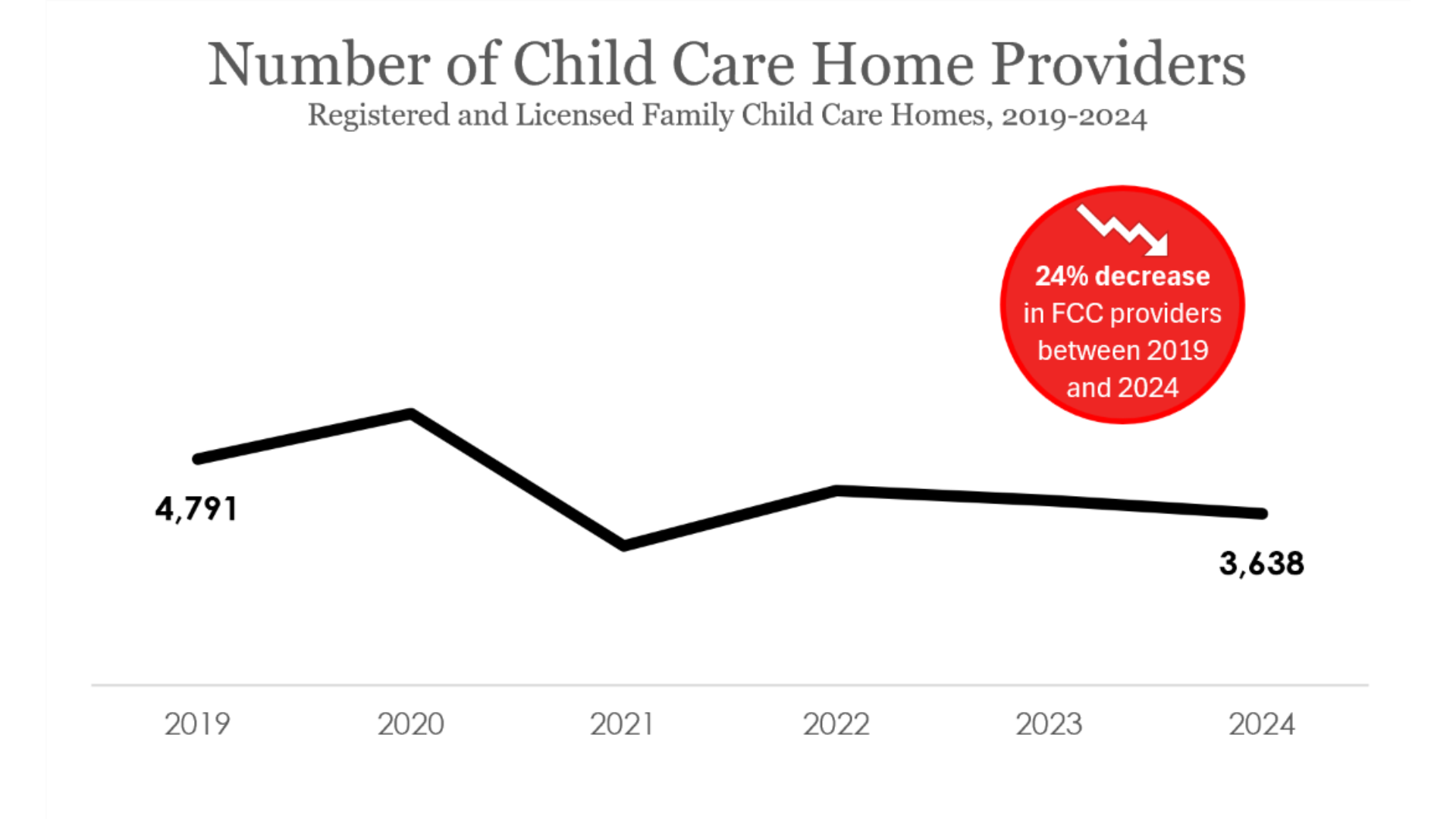
The next section of the report discusses child care deserts in Texas, particularly as they relate to children ages 0-5 of working parents who are low-income.
Child Care Deserts in Texas
Every year, CHILDREN AT RISK analyzes data to assess the supply and demand for child care from every zip code across the state and identify areas of Texas lacking adequate child care options for the number of children residing in those communities. A zip code is deemed a “child care desert” if the number of children under age 6 with working parents is three times greater than the licensed capacity of child care providers in the area.
You can explore our Texas child care desert map here.
88.2% of children from low-income families, around 515,000 low-income children under age 6 with working parents, live in a zip code where the supply of subsidized child care meets less than a third of the demand. Similarly, more than nine in ten low-income children ages 0-5, or 92.7%, live in a Texas Rising Star desert. This means even though roughly two in ten Texas children ages 0-5 with working parents live in a child care desert overall, low-income families have a much more challenging time not only finding child care, but finding quality child care.
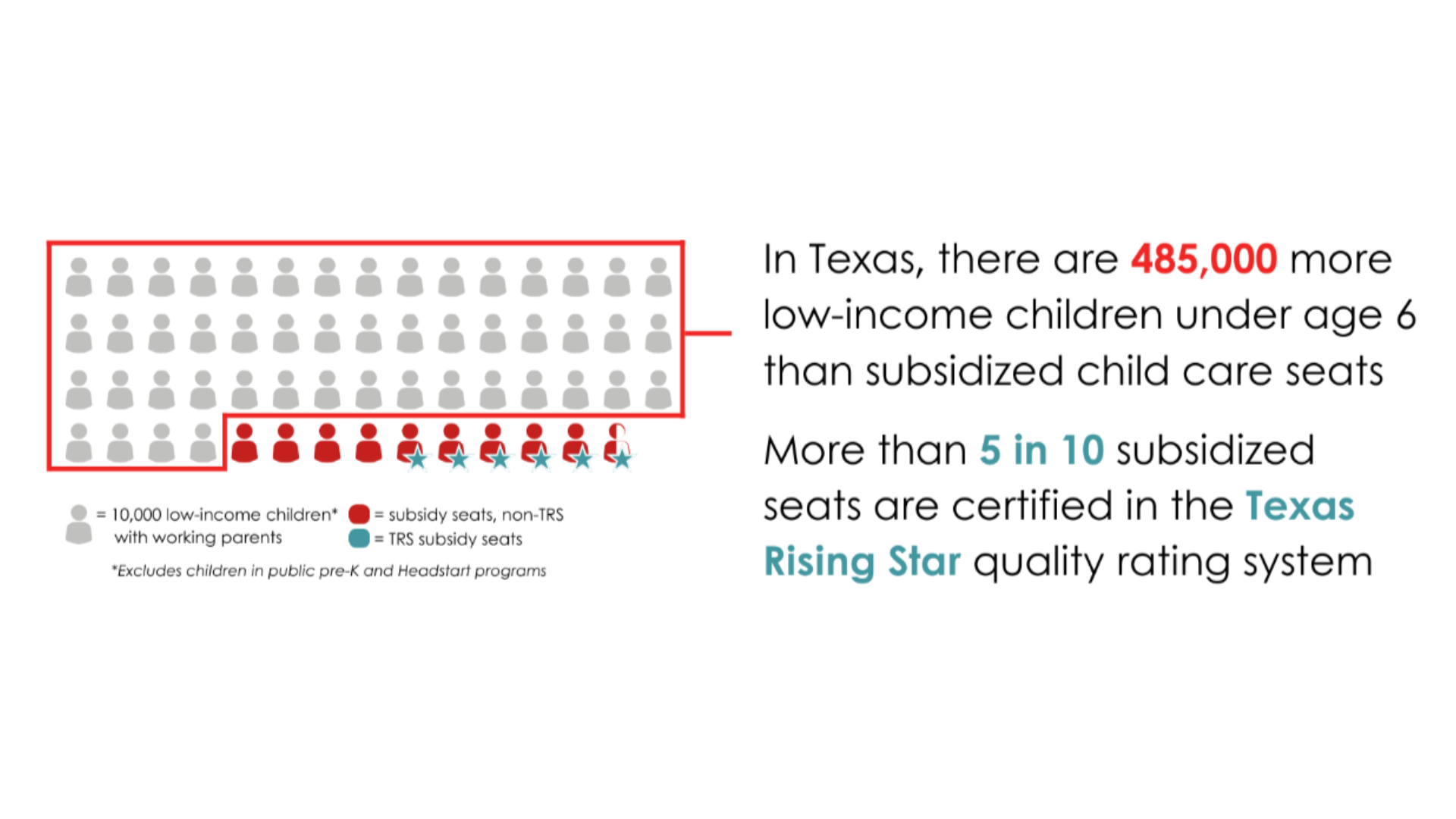
In Texas, there are an estimated 485,000 more low-income children ages 0-5 with working parents than available subsidized child care seats. Of the subsidized child care seats available to children of all ages, close to 50,000 are allotted to school age children. This means over one in six, or 16.8%, low-income children ages 0-5 with working parents not participating in Head Start/Early Head Start or Public Pre-K programs are served through the Texas Workforce Commission.
The data demonstrate the lack of access to quality early child care is nearly universal throughout Texas among low-income families.
Summary and Call to Action
The Texas Legislature passed HB 2607 in 2021 which mandates participation in TRS for child care providers receiving subsidy reimbursement. This has resulted in:
- A 41% increase in provider participation in TRS between 2023 and 2024
- A decrease in zip codes defined as TRS child care deserts (981 to 850)
As a result of these gains, there has been an increase in the actual number of TRS child care seats per 100 low-income children of working parents, highlighting the strides made toward increasing access to high-quality subsidized child care in the state.
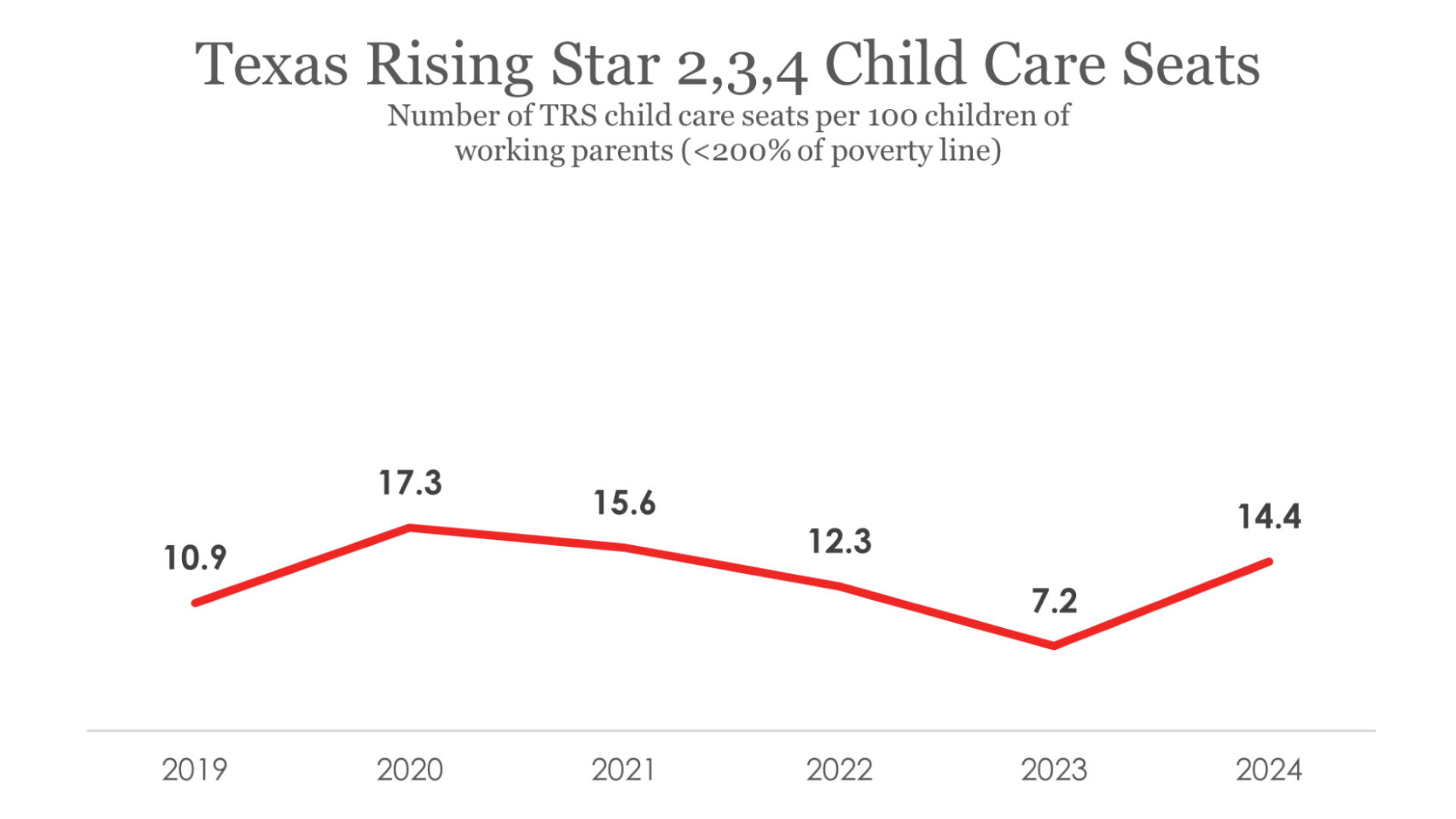
With more than half of our child population with working parents living below 200% of the federal poverty line, we must continue to advocate for access to quality child care programs that parents can afford while working. Through September 2023, child care programs had the additional financial support of the Child Care Relief Funds made available through the federal COVID-19 relief dollars, which proved vital in keeping child care programs open. With the knowledge those dollars were ending and the child care industry still unstable, the 88th Legislature passed SB 1145 to provide property tax relief to eligible child care programs, providing some financial relief beginning in 2024.
However, more needs to be done to provide families access to high quality child care which has historically been under funded in Texas. As advocates and policymakers are working throughout the 89th Legislative Session, decisionmakers should consider the following actions to improve the state of child care in Texas:
- Invest in child care through direct care of children, reimbursement rates, and child care supply funding;
- Consider business tax incentives for businesses supporting child care for employees;
- Remove local patchwork regulatory burdens that burden Texans who want to open family child care homes;
- Prioritize income-eligible child care employees for child care scholarships for their own children; and
- Reduce administrative obstacles to develop public-private Pre-K partnerships.
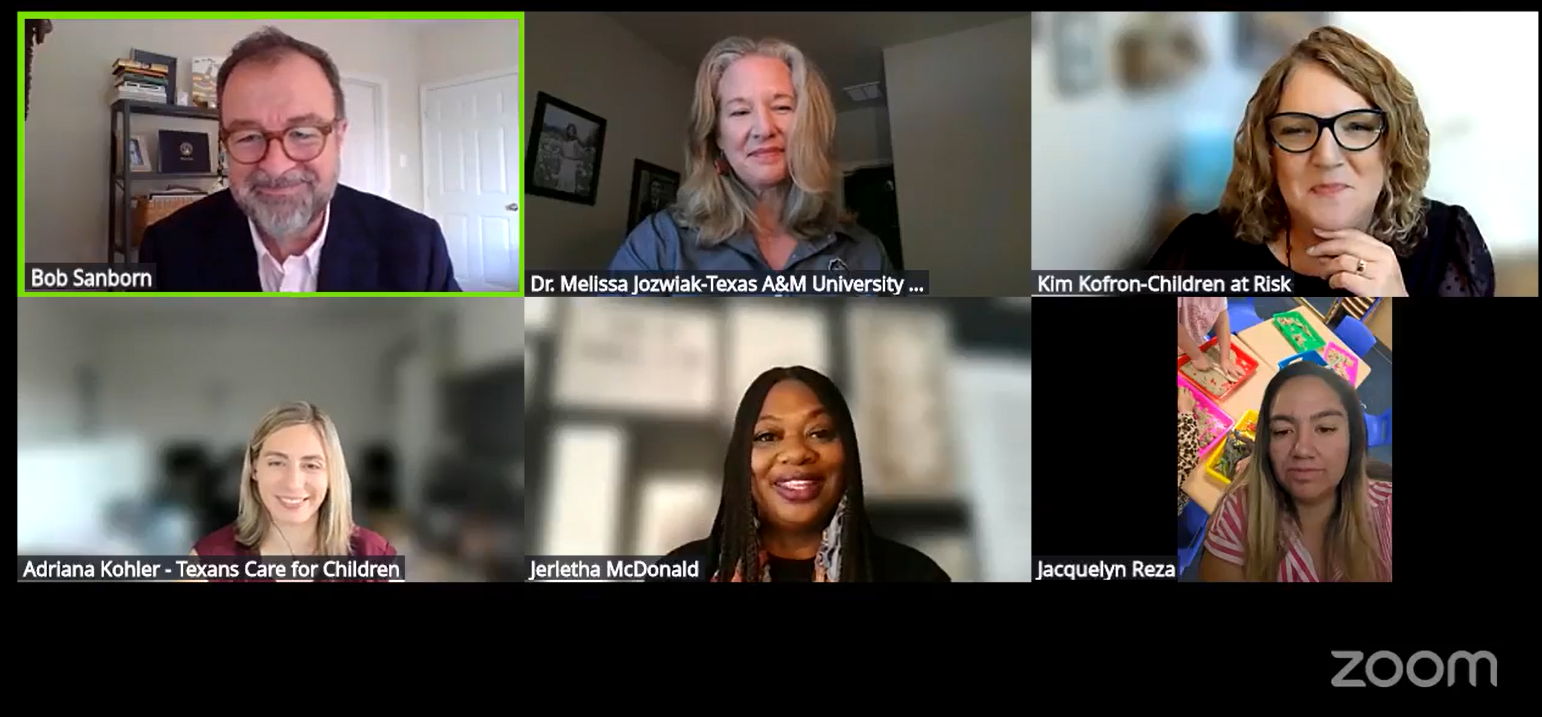
Monday, April 14th, C@R Hosted a Virtual Press Conference to Share Key Findings.
FEATURING
Dr. Bob Sanborn, President & CEO, CHILDREN AT RISK
Kim Kofron, Sr. Director of Education, CHILDREN AT RISK
Adriana Kohler, Policy Director, Texans Care for Children
Jacquelyn Reza, Director/Owner of Flower in the Garden Child Care Center in El Paso
Jerletha McDonald, CEO & Founder, DFW Family Child Care Network
Dr. Melissa Jozwiak, Professor of Early Childhood, Texas A&M University-San Antonio
Stay Informed
Sign up for our Early Education Statewide newsletter for updates during the interim, our latest research, policy analysis, and ways you can take action!
READ MORE FROM C@R

Fall 2023 Texas Tour Recap
Kaitlyn Newell, Associate Director of Early Education, speaks to a group of child care providers, policymakers, and business leaders in Midland, TX. Source: CHILDREN AT RISK(TX – November 16, 2023) – Each Fall the CHILDREN AT RISK Early Childhood Team sets out on our...
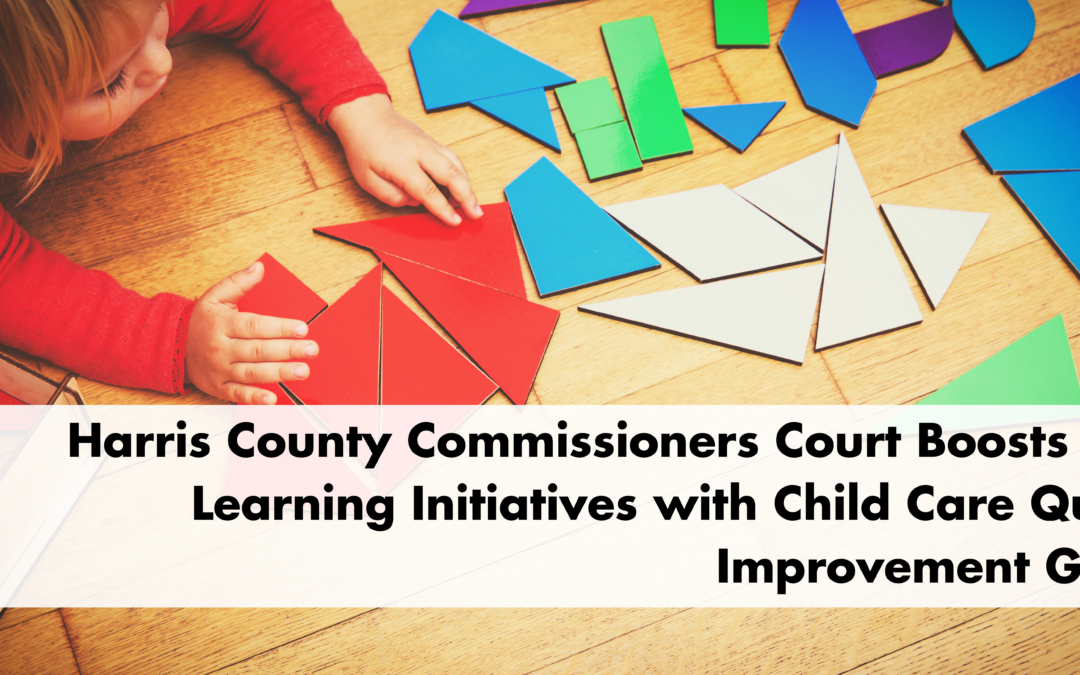
Harris County Commissioners Court Boosts Early Learning Initiatives with Child Care Quality Improvement Grants
Harris County Commissioners Court Boosts Early Learning Initiatives with Child Care Quality Improvement Grants The Harris County Early Learning Quality Networks Grants Empower Local Organizations to Amplify Their Voice in Education. (Harris County – October 19,...

ECE Texas Tours – Fall 2023
Throughout the month of October, CHILDREN AT RISK will be hosting community conversations across 12 cities in Texas, discussing the effects of the 88th Regular Legislative Session on Early Childhood Education and next steps for continuing to build a robust child care...

How did Children Fare in the 88th Texas Legislative Session?
Over the 140 days of the 2023 Regular Texas Legislative Session, approximately 11,800 bills were filed, and 4,550 passed. CHILDREN AT RISK showed up strong, registering support for bills 79 times, and providing expert testimony on legislation 29 times. In addition to...
C@R Texas House Select Committee on Educational Opportunity and Enrichment 7.11.23
Chairman Buckley, Vice Chair Gervin-Hawkins, and Members of the Select Committee: My name is Kim Kofron, Senior Director of Education. We are grateful to the Texas House of Representatives and Speaker Dade Phelan for the creation of this Select Committee and for your...

The Power of Immigrants that Texas Does Not Seem to Want to Understand
By Linda Corchado & Bob Sanborn The data is clear. A third of Texas’ nearly 8 million children are immigrants or the children of immigrants. In our cities, like Houston, the number is about half of our children. If children are our future then our path forward...

CHILDREN AT RISK Hosts The Future of Children Summit
The 2023 Future of Children Summit was introduced by Dr Robert Sanborn, President & CEO at CHILDREN AT RISK with Welcome Remarks The summit was broken down into seven sections that lasted 11 minutes followed by a brief Q&A led by Dr Bob and the speaker....